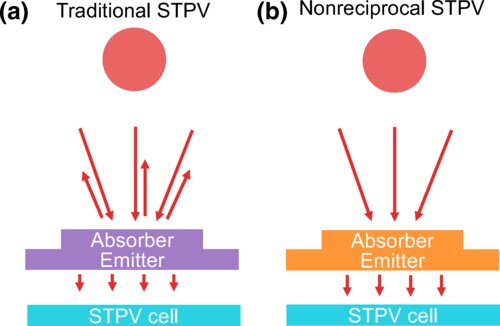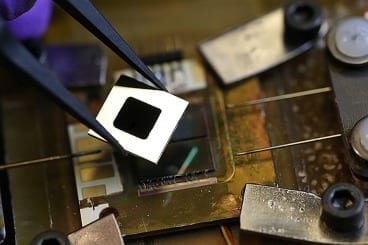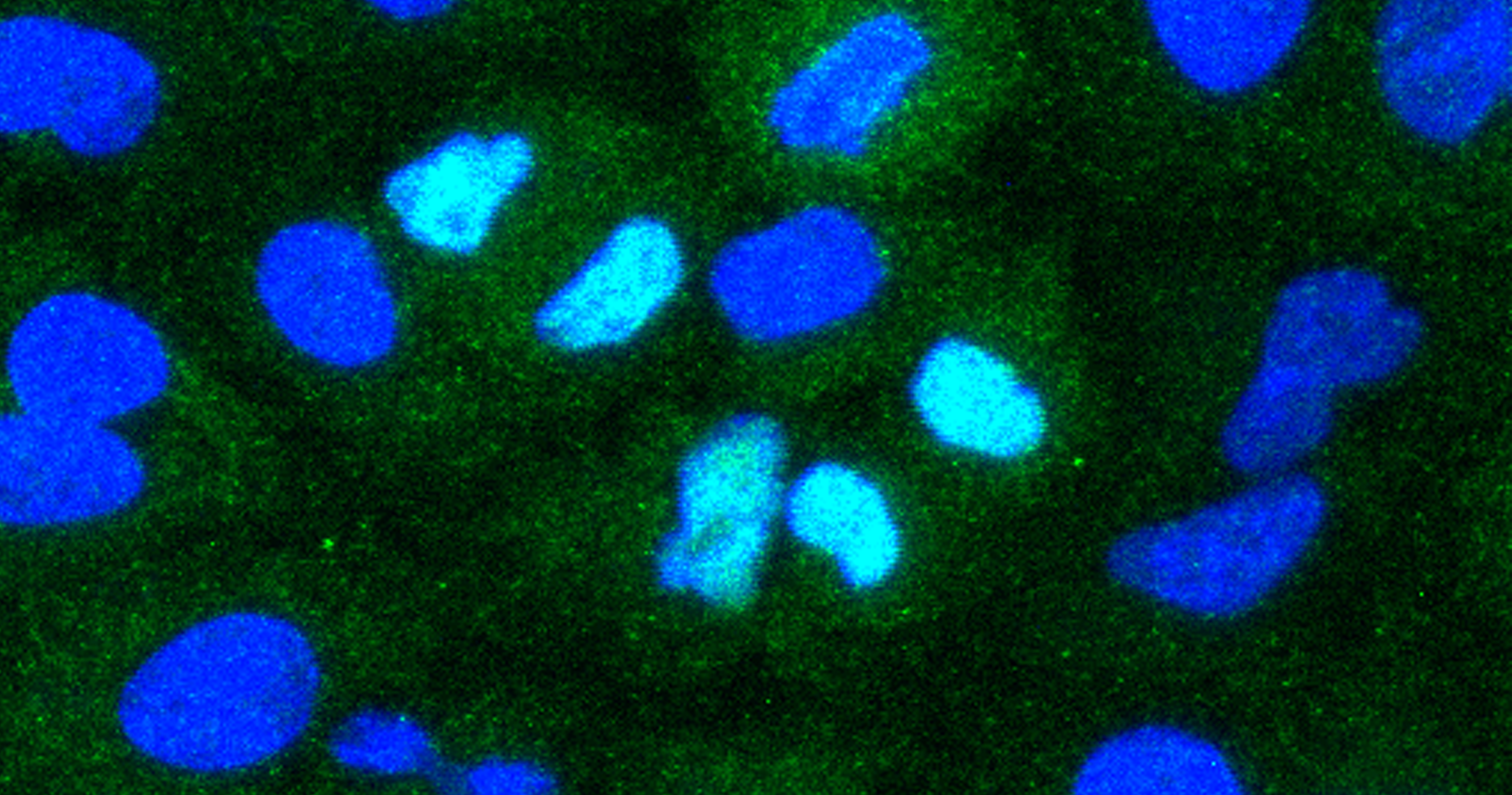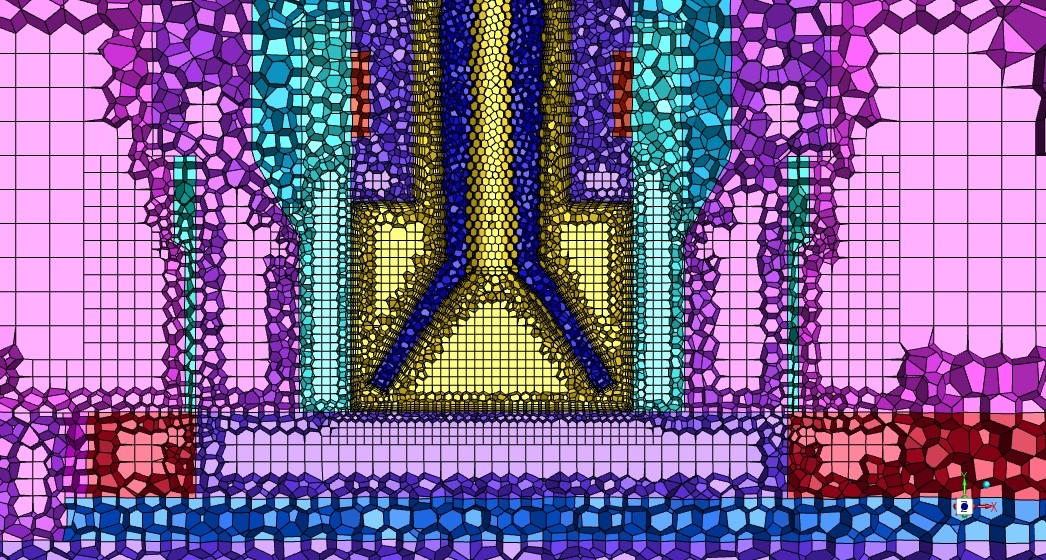
(a) Illustration of traditional STPV and (b) nonreciprocal STPV. The absorber of traditional STPV has back radiation towards the sun. In nonreciprocal STPV, the back emission from the intermediate layer is suppressed, and more incoming energy is directed towards the cell. The nonreciprocal behavior of the intermediate layer can be made wavelength selective.
Credit: Sina Jafari Ghalekohneh et al, Physical Review Applied (2022). DOI: 10.1103/PhysRevApplied.18.034083
The great inventor Thomas Edison once said, “So long as the sun shines, man will be able to develop power in abundance.”
His wasn’t the first great mind to marvel at the notion of harnessing the power of the sun; for centuries inventors have been pondering and perfecting the way to harvest solar energy.
They’ve done an amazing job with photovoltaic cells which convert sunlight directly into energy. And still, with all the research, history and science behind it, there are limits to how much solar power can be harvested and used – as its generation is restricted only to the daytime.
A University of Houston professor is continuing the historic quest, reporting on a new type of solar energy harvesting system that breaks the efficiency record of all existing technologies. And no less important, it clears the way to use solar power 24/7.
“With our architecture, the solar energy harvesting efficiency can be improved to the thermodynamic limit,” reports Bo Zhao, Kalsi Assistant Professor of mechanical engineering and his doctoral student Sina Jafari Ghalekohneh in the journal Physical Review Applied. The thermodynamic limit is the absolute maximum theoretically possible conversion efficiency of sunlight into electricity.
Finding more efficient ways to harness solar energy is critical to transitioning to a carbon-free electric grid. According to a recent study by the U.S. Department of Energy Solar Energy Technologies Office and the National Renewable Energy Laboratory, solar could account for as much as 40% of the nation’s electricity supply by 2035 and 45% by 2050, pending aggressive cost reductions, supportive policies and large-scale electrification.
How Does it Work?
Traditional solar thermophotovoltaics (STPV) rely on an intermediate layer to tailor sunlight for better efficiency. The front side of the intermediate layer (the side facing the sun) is designed to absorb all photons coming from the sun. In this way, solar energy is converted to thermal energy of the intermediate layer and elevates the temperature of the intermediate layer.
But the thermodynamic efficiency limit of STPVs, which has long been understood to be the blackbody limit (85.4%), is still far lower than the Landsberg limit (93.3%), the ultimate efficiency limit for solar energy harvesting.
“In this work, we show that the efficiency deficit is caused by the inevitable back emission of the intermediate layer towards the sun resulting from the reciprocity of the system. We propose nonreciprocal STPV systems that utilize an intermediate layer with nonreciprocal radiative properties,” said Zhao. “Such a nonreciprocal intermediate layer can substantially suppress its back emission to the sun and funnel more photon flux towards the cell.
We show that, with such improvement, the nonreciprocal STPV system can reach the Landsberg limit, and practical STPV systems with single-junction photovoltaic cells can also experience a significant efficiency boost.”
Besides improved efficiency, STPVs promise compactness and dispatchability (electricity that can be programmed on demand based on market needs).
In one important application scenario, STPVs can be coupled with an economical thermal energy storage unit to generate electricity 24/7.
“Our work highlights the great potential of nonreciprocal thermal photonic components in energy applications. The proposed system offers a new pathway to improve the performance of STPV systems significantly. It may pave the way for nonreciprocal systems to be implemented in practical STPV systems currently used in power plants,” said Zhao.
Original Article: Solar Harvesting System has Potential to Generate Solar Power 24/7
More from: University of Houston
The Latest Updates from Bing News
Go deeper with Bing News on:
Solar thermophotovoltaics
- How much do solar panels cost in 2024?
How much does it cost to install solar panels? Most installers set the price according to the system's wattage, with a typical cost between $2.50 and $5 per watt. The cost per watt is what you pay ...
- Best Solar Panels For Homes Of 2024
Commissions do not affect our editors' opinions or evaluations. Solar panels and their accessories unlock the boundless energy from sunshine and transform it into useful energy at home.
- Solar Energy News
Apr. 8, 2024 — Researchers have fabricated a new four-terminal organic solar cell with a tandem configuration with a 16.94% power conversion efficiency (PCE). The new device is composed by a ...
- The Best Solar Companies in Wisconsin (2024)
Aniket Bhor is a solar engineer who has spent nearly a decade studying and working in the solar power sector in the European, Asian and North American markets. He is a climate enthusiast and avid ...
- The Best Solar Generators for at Home or On the Go, Tested
Also called solar “power stations,” solar generators feature high-capacity batteries that store energy that can be used to power appliances and digital devices. Unlike traditional generators ...
Go deeper with Bing News on:
Nonreciprocal STPV systems
- Best Home Security Systems Of 2024
Commissions do not affect our editors' opinions or evaluations. Home security systems help keep your family and possessions safe while you’re home or away. The best home security systems provide ...
- Best DIY Home Security Systems of 2024
Macy Meyer is a N.C. native who graduated from UNC-Chapel Hill in 2021 with a B.A. in English and Journalism. She currently resides in Charlotte, N.C., where she has been working as an Editor I ...
- Best Home Security Systems of May 2024
Our experts have taken the time to review the best home security systems on the market, breaking them up by customer focus and benefit. Ready to learn more? We’ve done the heavy lifting for you ...
- 7 Best ERP Systems of May 2024
Kimberlee Leonard has more than 20 years of experience in creating content for various publications. She’s a small business and finance expert who takes complex topics and simplifies them so ...
- Best POS systems in 2024
Digital point-of-sale (POS) systems are increasingly prevalent technology for small businesses. Whereas the cash registers of old could only calculate transactions, today’s POS devices can also ...










